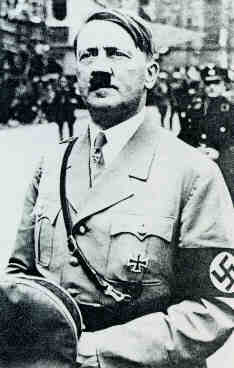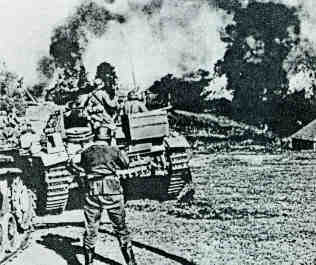
Nazi German leader (Fuehrer) Adolf Hitler had great plans for Ukraine, the rich breadbasket of Europe, as a Lebensraum (living space) for the German nation. He planned to empty Ukraine of 40 million Ukrainians, leaving only some as slave laborers for German colonists. He planned that Ukraine and Ukrainians would "disappear".
When Hitler on June 22, 1941 launched his Drang nach Osten (Drive to the East) Operation Barbarossa invasion plan at 3 A.M. by attacking the borders of Ukraine and Belarus in the USSR he was starting a war of annihilation. The German Blitzkrieg, or "lightning war" involved new concepts of warfare, highly mechanized and supported by airpower. It also involved the racist ideas of Hitler, Himmler and Goering which called for the destruction of the Untermensch, or sub-humans, including the Jews and the Ukrainians, classed as sub-human. Some 40 million Ukrainians were in the way because they were occupying the rich, black earth of Ukraine which Hitler had decided was to be the new Lebensraum, or living space, of the German nation. In fact, Hitler chose Ukraine over Moscow as a priority in the invasion even against the advice of his Generals.
Hitler's Wehrmacht, the German Army, with over 3,000,000 troops attacked the border of Ukraine (Ukrainian SSR) and the USSR. On the first day such Ukrainian cities as Kiev, Odessa and Lviv were bombed. Stalin was taken by surprise although he had warning of the impending attack weeks ahead and the USSR was not prepared because of his incompetence. As the powerful German forces swept eastward they captured huge territories of Ukraine, Europe's largest country, because there was little resistance. In fact, some of the villages and cities of Ukraine welcomed the German Army with flowers or the traditional Ukrainian bread and salt of hospitality and friendship. These German soldiers were pleasantly surprised that they were welcomed and regarded as liberators from the Communist Russian yoke of Moscow.
The reasons for Ukrainian disenchantment with the USSR were clear. First of all the 1930s Soviet collectivization of all private farms took away the land and livestock of all the farmers. (Incidentally, the Germans maintained the collective farms as "cooperative farms".) In 1933 Ukraine suffered a man-made famine organized by Lazar Kaganovich, a henchman who followed Stalin's orders to the letter. About 7,000,000 Ukrainians died of starvation in this famine according to Robert Conquest.
Later in the 1930s thousands of Ukrainians were arrested and started disappearing including intelligentsia, writers, artists and even musicians whose patriotism was suspected by the NKVD Soviet secret police. This repression of writers, poets and playwrights, was called the Rozstrilaniy vidrodzhennia or "Executed Renaissance" period of Ukrainian literature. Both the Ukrainian churches, Orthodox and Catholic, were banned and only the Russian Orthodox Church was allowed to function in Ukraine. Incidentally, the Ukrainian Orthodox and Ukrainian Catholic Churches, banned by the Kremlin, were allowed to function under the Germans. The Soviet terror of the 1930s convinced many Ukrainians that there was nothing worse than Communist Russian slavery and nothing more welcome than the Army representing such a cultured nation as Germany.
Proof of the Ukrainian disenchantment with Stalin is the fact that the largest army to surrender in the history of the world was in the 1941 Battle of Kiev when a total of 665,000 soldiers were captured by the Germans out of a Soviet Red Army of 677,085. Unfortunately for these men, who surrendered so willingly, Nazi German racist plans at this time called for their destruction so they were intentionally starved to death or died of exposure in open air concentration camps in the winter of 1941-42. Germany had sufficient food stockpiled so shortages were not a problem at the time. But only two weeks after the invasion the Germans started the open persecution of the Ukrainian nation.

German Wehrmacht (Army) and Panzer Tanks advancing through the burning Ukrainian village of Nyzhny Nanoichyk in 1941.